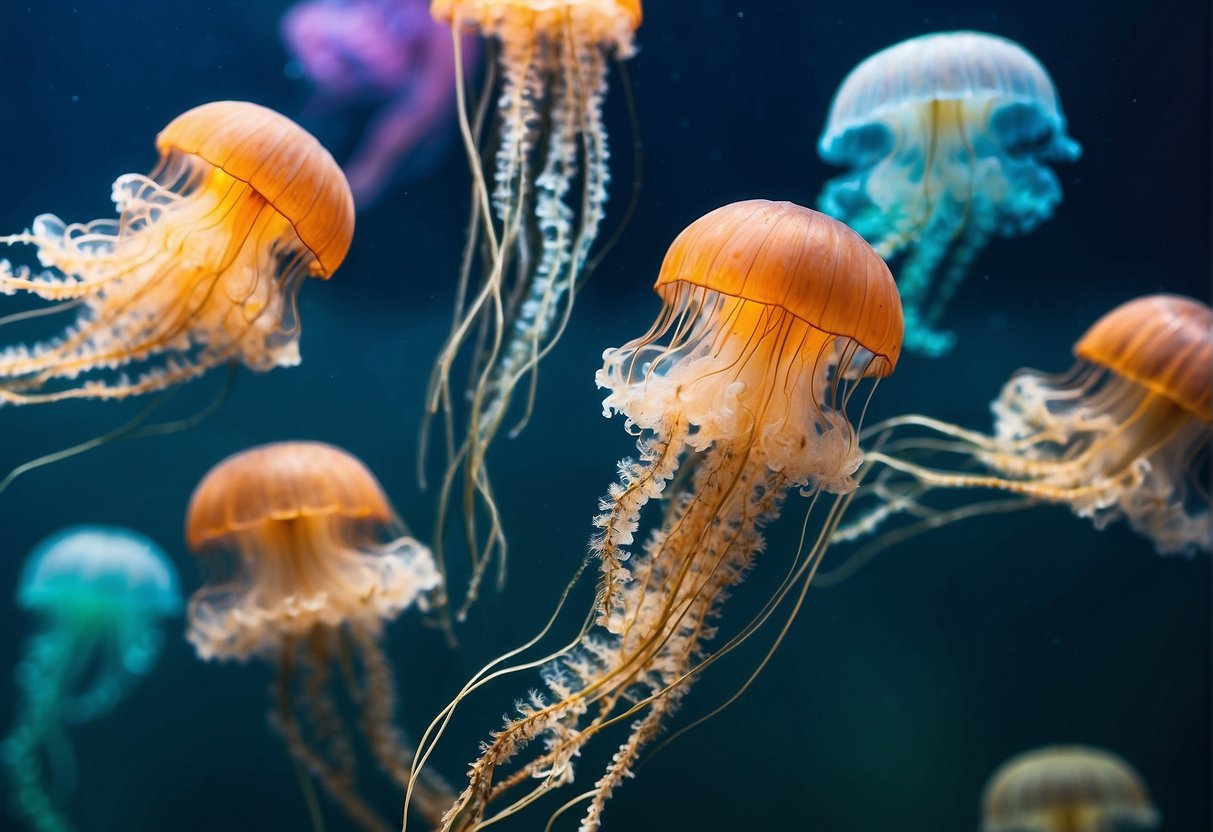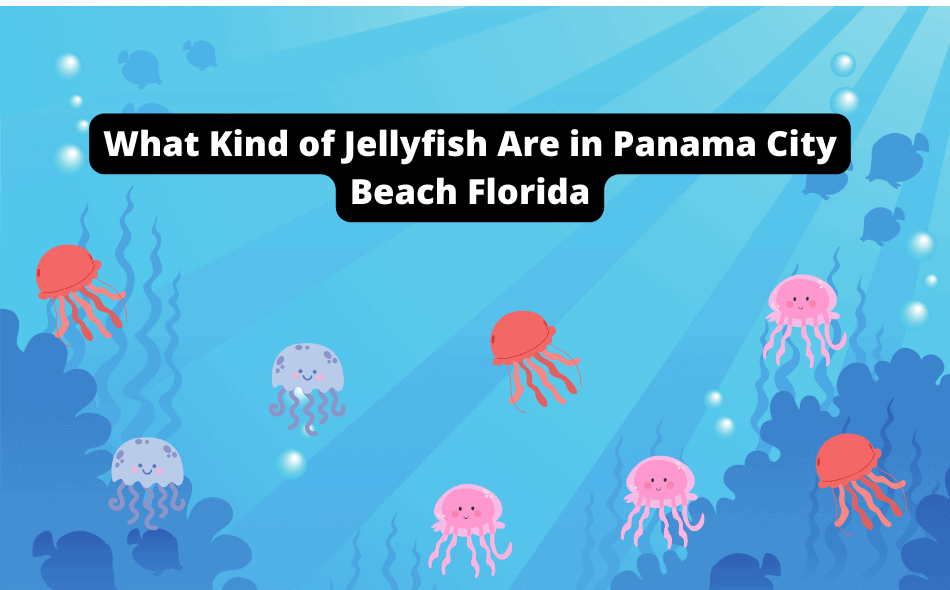Overview of Jellyfish in Panama City Beach
Jellyfish are fascinating marine creatures that can be found in the waters of Panama City Beach.
As we explore the different types of jellyfish species in this area, it is important to note that some of them can be harmful to humans.
Common Jellyfish Species
Moon jellyfish are one of the most common species found in Panama City Beach.
They are easily identifiable by their translucent appearance and the four-leaf clover shape in the middle of their bells.
Moon jellyfish are not considered harmful to humans.
Another common species found in the area is the cannonball jellyfish.
They are typically found in warm, temperate seas and populate the Gulf of Mexico, including the Panama City Beach shoreline.
While their sting is generally mild, beachgoers need to exercise caution.
Sea nettles are also present in the waters of Panama City Beach.
They have long, slender tentacles and can deliver a painful sting to humans.
The pink meanie is a rare species that has recently been discovered in the area.
It has a distinctive pink color and can cause a mild to moderate sting.
Jellyfish Habitats and Range
Jellyfish can be found in a variety of habitats, including coastal waters, open oceans, and even freshwater lakes and rivers.
In Panama City Beach, they are most commonly found in the Gulf of Mexico.
It is important to note that jellyfish populations can vary depending on some factors, including water temperature, salinity, and food availability.
As such, it is difficult to predict exactly where and when jellyfish will be present in Panama City Beach.
Jellyfish and Human Interactions
Jellyfish are a common sight in Panama City Beach, Florida, especially during the summer months.
While most jellyfish species found in this area are harmless to humans, some can deliver painful stings that require medical attention.
In this section, we will discuss how to avoid jellyfish stings and what to do if you get stung.
Sting Treatment and Prevention
Jellyfish stings can cause skin irritation, pain, and in some cases, severe allergic reactions.
If you get stung, the first thing you should do is rinse the affected area with vinegar.
Vinegar can help neutralize the stinging cells and prevent the release of more toxins into your skin.
After rinsing with vinegar, you can remove any tentacles that may be stuck to your skin using a pair of tweezers or a credit card.
Do not use your hands to remove the tentacles, as this can cause more stings.
Once the tentacles are removed, you can soak the affected area in hot water for 20-45 minutes to help relieve the pain.
To prevent jellyfish stings, it’s important to avoid swimming in areas where jellyfish are known to be present.
You can check with local authorities or lifeguards to find out if there have been any recent sightings.
If you do decide to go swimming, wearing a wetsuit or other protective clothing can help reduce your risk of getting stung.
Safety Tips for Beachgoers
If you’re planning a trip to Panama City Beach during jellyfish season, there are several safety precautions you can take to reduce your risk of getting stung. These include:
- Avoid swimming in areas where jellyfish are known to be present.
- Wear protective clothing, such as a wetsuit or rash guard.
- Stay alert and watch for jellyfish in the water.
- Swim with a buddy and keep an eye on each other.
- If you see a jellyfish, swim away slowly and calmly.
- Follow the instructions of lifeguards and other beach officials.
By following these safety tips and knowing how to treat jellyfish stings, you can enjoy your time at the beach without worrying about these fascinating creatures.
Ecological Significance and Conservation
As we have discussed earlier, jellyfish play a crucial role in the marine ecosystem as they are both predator and prey.
They feed on plankton and small fish, and in turn, they are food for larger predators such as sea turtles.
However, some species of jellyfish can outcompete other species and disrupt the balance of the ecosystem.
Conservation efforts for jellyfish are often focused on protecting sea turtles, which are threatened by the consumption of plastic debris that jellyfish can sometimes resemble.
Additionally, scientists are studying jellyfish populations to better understand their reproductive patterns and how they respond to changes in their environment.
In recent years, scientists have discovered new species of jellyfish in Panama City Beach, which highlights the importance of continued research and conservation efforts.
We must protect these fascinating creatures and maintain the balance of our marine ecosystem.
Frequently Asked Questions About Jellyfish in Panama City Beach

Which species of jellyfish are most prevalent in the waters near Panama City Beach?
Several species of jellyfish are commonly found in the waters near Panama City Beach.
Among them are the moon jellyfish, the cannonball jellyfish, and the blue button jellyfish.
While the moon jellyfish is the most common, other species can be found in the area as well.
What are the distinguishing features of moon jellyfish found in Panama City Beach?
Moon jellyfish are typically translucent, with a saucer-shaped bell that can reach up to 12 inches in diameter.
They have short, frilly tentacles that are arranged in a circular pattern around the bell.
The tentacles are lined with tiny, stinging cells called nematocysts, which the jellyfish use to capture prey.
During which months is jellyfish activity at its peak in Panama City Beach?
Jellyfish activity in Panama City Beach typically peaks during the summer months, from May to September.
During this time, warm water temperatures and increased tourism can lead to higher numbers of jellyfish in the area.
However, jellyfish can be present in the waters year-round.
Can you identify the types of jellyfish that have a blue hue commonly seen around Panama City Beach?
The blue button jellyfish is a species that is commonly seen around Panama City Beach and has a distinctive blue hue.
These jellyfish are small, with a bell that is typically less than an inch in diameter.
They have short, hair-like tentacles that are arranged in a circular pattern around the bell.
What characteristics define the comb jellyfish found along the shores of Panama City Beach?
The comb jellyfish, also known as the sea walnut, is a species that is found along the shores of Panama City Beach
. These jellyfish have a distinctive oval-shaped body that is covered in rows of tiny, hair-like cilia.
The cilia are used to propel the jellyfish through the water and to capture prey.
Are there any particular jellyfish in the Florida Panhandle known for lacking tentacles?
Yes, the mushroom cap jellyfish is a species that is known for lacking tentacles.
Instead, these jellyfish have a smooth, dome-shaped bell that is typically less than an inch in diameter.
They are often found washed up on the beach, and can pose a risk to beachgoers who come into contact with them.
